Chasing Chinatown | A Cinematic Perspective on Sunset Photography
For the uninitiated, the film Chinatown (1974) follows private detective J.J. “Jake” Gittes’ (Jack Nicholson) pursuit of what at first seems to be a simple case of adultery. It eventually evolves into a web of grim intrigue that includes everything from murder to the graft and fraud that may or may not have given birth to modern Los Angeles. The screenplay, by Robert Towne, is widely considered to be the greatest screenplay of all time.
Like other great art, Chinatown stands as one of those rare creative achievements that exist as experience rather than entertainment. You’re as exhausted and bewildered by what you just witnessed as Jake is when the credits start to roll over the final crime scene. By that point, you and Jake also know said crime scene will be buried under the same sort of lies that form the very foundation of the conspiracy he just spent the last 131 minutes piecing together.
Anchoring the film around the story is director Roman Polanski’s, and cinematographer John Alonzo’s, use of imagery that juxtaposes beauty with a menacing, sinister dynamic - a sort of Venn diagram where beauty and menace exist simultaneously. Polanski uses this juxtaposition to bury clues to great effect, and repeated viewings reward a critical eye with foreshadowing that is next level. A bullet hole that pierces a very specific section of a windshield. The manner in which femme fatale Evelyn Mulwray (Faye Dunaway) strokes her eyebrow after a close encounter with gunfire. The double-meanings behind many of the things chief antagonist Noah Cross (John Huston) says.
This technique is most apparent, however, across the four scenes that take place at sunset that masterfully, and simultaneously, obfuscate and reveal the most important clues of the story. Beauty and menace in equal measure, wrapped around water and the importance water plays in the narrative, and veiled by brilliant southern California sunsets. These scenes are seared into my memory, and I’ve been chasing them for decades, but it wasn’t until I picked up a camera that their importance to me finally resonated.
As Jake might say:
[Jack Nicholson delivery] “There are these four scenes in the film, see, and they form a perfect cinematic Venn diagram where beauty and menace are captured in equal measure, and they all take place at sunset. And I’m pretty sure that when I have my camera in hand during day’s end, these four scenes are running like an operating system in the background of my mind.”
Maybe this is why I prefer detached, desolate subjects that are often awash in vibrant colors. They’re beautiful. They’re also quietly menacing and not just a little sinister. They are a perfect collision between diametrically opposed forces. To capture that perfectly, even if it’s only once in my life, is worth the chase.
Below you’ll find write-ups for each of the four scenes, along with stills from the film and examples of my own photography where this subconscious intersection is visible.
The Scenes
Scene #1 – Point Fermin Surveillance
In pursuit of what he thinks is at first a run-of-the-mill adultery investigation, Gittes follows his mark, Hollis Mulwray, the Chief Engineer of the city’s Department of Water & Power, around Los Angeles, eventually capturing photographs of what Gittes assumes is a triste that confirms the accusations. Along the way, however, the detective unwittingly witnesses Mulwray investigating a mystery of his own, one that Gittes will be forced by circumstance to piece together himself after Mulwray is found dead. During his surveillance, Gittes follows Mulwary to Point Fermin and observes him at sunset immediately before a drain Gittes is sitting in front of erupts with water, a crucial clue that’s only revealed as such much later in the film. The photographic composition of this scene contains several impressive elements. The use of foreground silhouettes that enhance the colors in the background, which itself is limited to only the extreme left of the frame. The full spectrum of colors that lead from the top of the frame to the bottom, because of their relegation to such a small space of the frame, demand your attention while concurrently communicating a subtle mystery about the right side of the frame, the only section of the image that is enshrouded in complete darkness. As with so many other reveals in the film, the pivotal clue revealed in this scene emanates unexpectedly from this darkness.

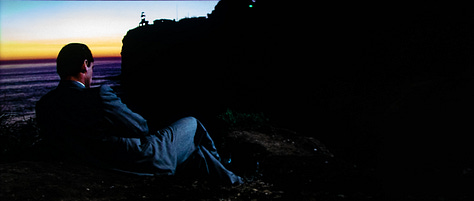
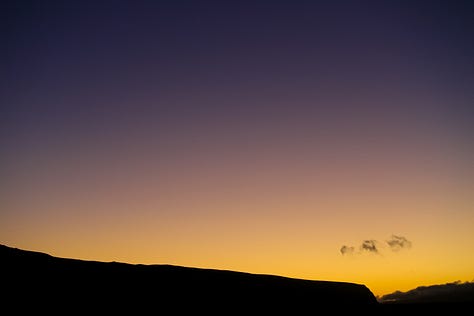
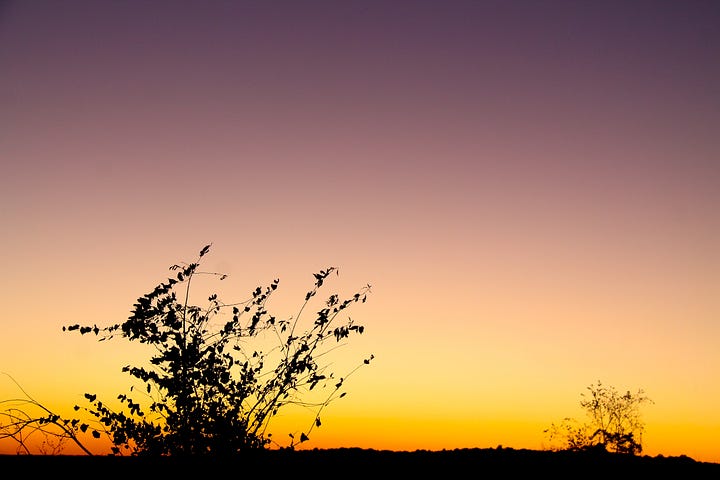
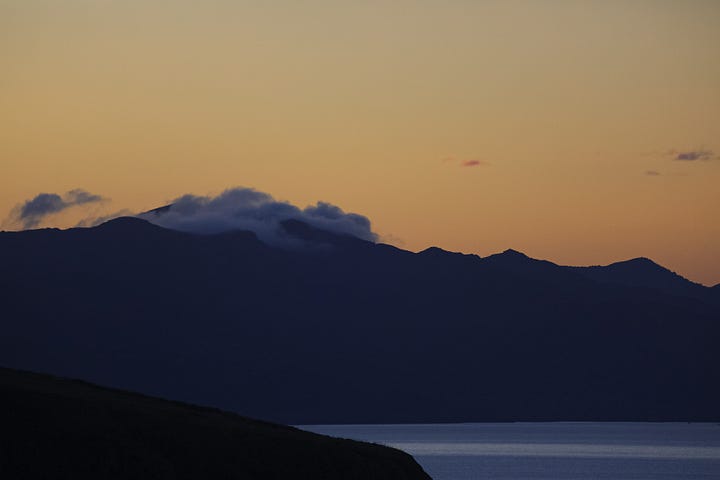
Scene #2 – Oak Pass Reservoir Investigation
Following the suspicious death of Hollis Mulwray, Gittes returns to the reservoir where Mulwray’s body was discovered. The visit to this location reveals a deepening conspiracy around the murder as well as a muscular effort to cover it up. Gittes loses a shoe, and, more painfully, almost loses his nose. The cinematography of this scene is enhanced significantly by the quiet subtly of crickets chirping and other night sounds that are slowly emerging as the light disappears. The dichromatic quality of this scene, featuring deep purples and blacks that occupy very specific spaces within the frame, create an ominous tone with the jagged, silhouetted mountain ridges cutting through the purple sky. The closer Gittes gets to the truth (last film still of this section), the more he becomes part of the blackness in a grim harbinger of things to come.

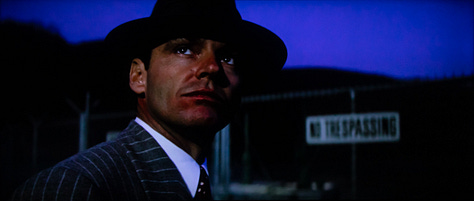

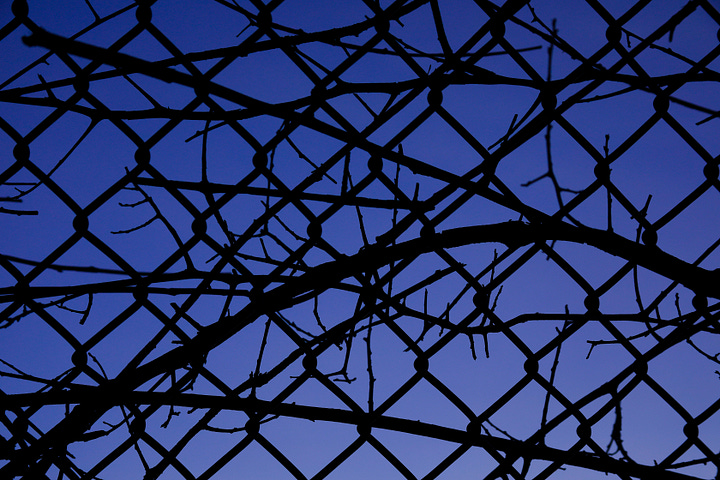

Scene #3 – Mar Vista Rest Home
Having by this point in the film teamed up with Mulwray’s widow, Evelyn Mulwray, Gittes unearths a land grab scheme at the Hall of Records. To confirm his suspicion, the two partners (who are also about to be lovers) travel to the Mar Vista Rest home. Once there, not only are his suspicions confirmed when the true beneficiaries of the Albacore Club (more water) are revealed, but the sinister forces working against them reveal themselves in larger numbers and willing to use more deadly force. Eveyln is nearly killed by pistol fire as she rescues Jake at the conclusion of a particularly violent altercation in the entryway of the rest home. The colors in these scenes are brighter hues than the previous sunset compositions, perhaps an indicator that Gittes is getting closer to understanding the full scope of the case. Lighter purples, pinks and light oranges fill the frames and the backgrounds are a mixture of silhouettes and visible topography. The combination of these lighter tones with the sinister plot reveals and violence, however, only make the dread and grim realities of a quickly deteriorating situation more visible.
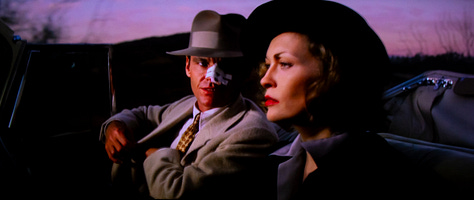

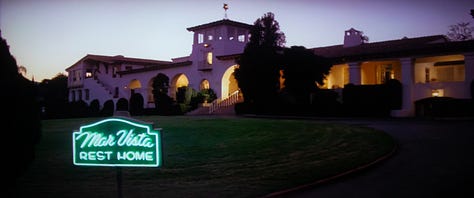


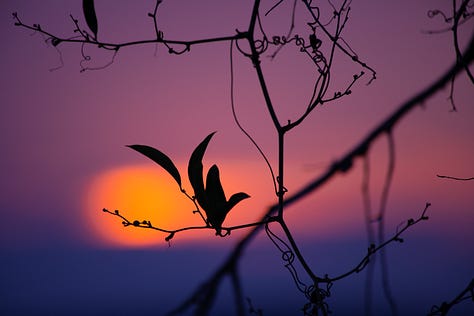
Scene #4 – The Final confrontation with Noah Cross
Few antagonists in cinema history are as complicated as Noah Cross. Surely, few, if any, are as politely diabolical. The folksy charm he comports himself with masks pure evil, and even though Gittes figures this out, he figures it out much too late to effectively stop Cross from completing both his land grab scheme and the retrieval of the daughter he fathered incestuously, Katherine Cross. The sunset in this scene is far less visible that the previous three, however, because of the scene’s duration, you can actually appreciate it in real time. The visibility of its progress is, perhaps, also a harbinger for the final, dreadful act. The light is literally fading on the day as Jake is forced by Cross and his henchman, Claude Mulvihill, to give up Evelyn and Katherine while standing in front of the salt-water pond Cross drowned Hollis Mulwray in earlier in the film. The end is near, signaled by the fading light that brings out deep blues, purples, and pinks.

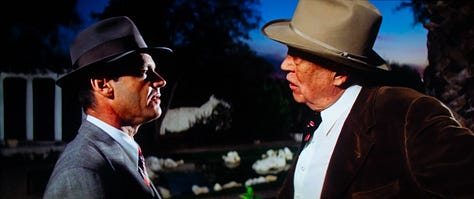
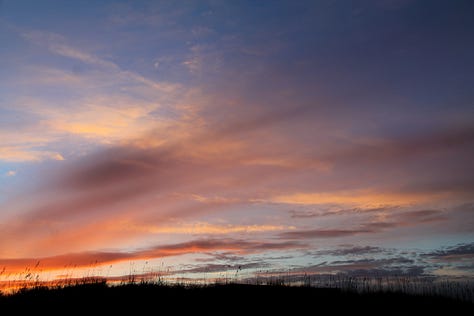
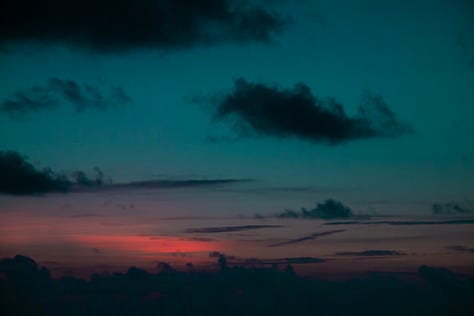


For more about all my photography and other art projects, please visit Fenwick Designs.





